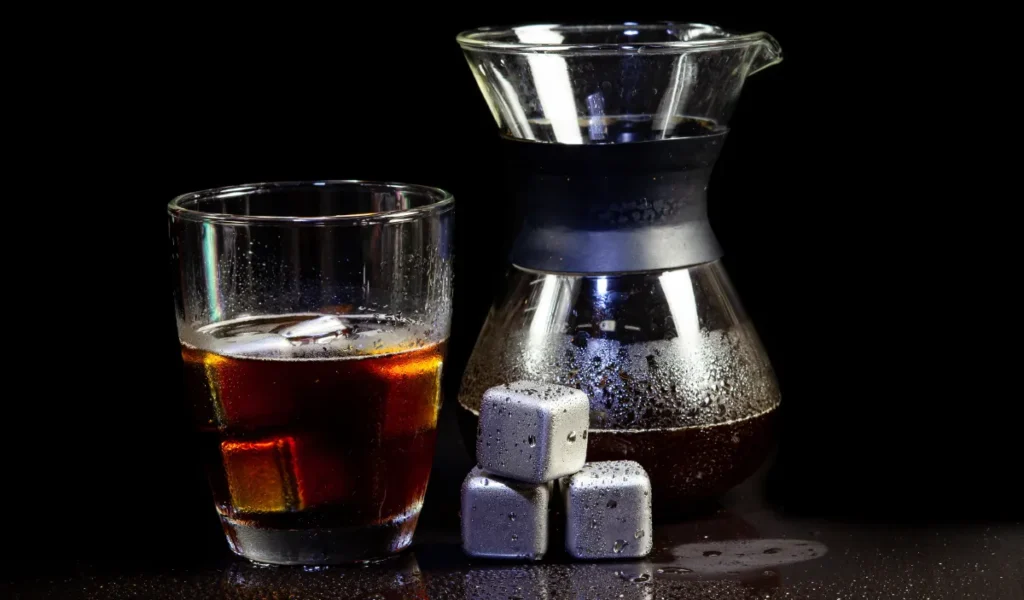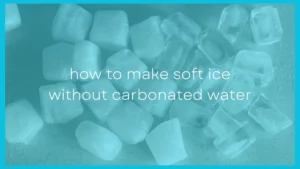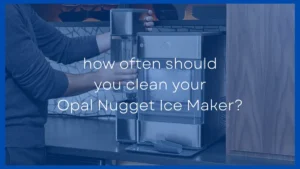Stainless steel ice cube are a common alternative to use in drinks like whiskey where you don't want the ice to dilute the drink but you still need something to keep things cold.
But you may know that stainless steel is a pretty good conductor of heat compared to water.
Do these stainless steel ice cubes actually stay cold for a long time and keep your drink cold? Or are they a waste of money and water ice cubes turns out to be a better solution?
Pure stainless steel ice cubes do NOT stay warm for very long and aren't very effective at keeping drinks cold. However, most “stainless steel ice cubes” are actually a stainless steel exterior coating with water inside them. They contain about half water per volume compared to regular ice cubes so they last roughly half as long as regular ice cubes would. However, they don't dilute your drink like regular ice cubes.
If stainless steel ice cubes were actually made from pure stainless steel they would work A LOT worse than regular ice cubes and the science behind how stainless steel ice cubes work compared to water-based ice cubes is fascinating.
Here's why water is more effective for keeping drinks cold, how stainless steel ice cubes actually use water to stay cold and why stainless steel ice cubes are still worthy of consideration in some circumstances.
Stainless Steel vs. Water: Which Stays Colder?
While stainless steel ice cubes will get cold faster, ice will keep drinks cold for longer.
This all comes down to a term known as “heat capacity”
The more heat capacity something has the more energy it takes to warm up or cool down that item.
To keep drinks cold you want a substance with an extremely high heat capacity as this will take much longer to warm up and will keep your drink colder for longer as a result.
When comparing stainless steel to water the heat capacities are extremely different and water outperforms steel by a wide margin.
Steel has a specific heat capacity of 490 joules per kilogram (J/kg C°). That means it takes 490 joules of energy to change the temperature of one kilogram of steel by 1°C.
Water has one of the highest specific heat capacities, at 4,182J/kg C°. That means it takes 4,182 joules of energy to change the temperature of one kilogram of water by 1°C.
Ice has less heat capacity than water at 2,093J/kg C°. This means it takes 2,093 joules of energy to change the temperature of one kilogram of water by 1°C.
In layman's terms, it takes more than four times as much energy to change the temperature of water versus the temperature of stainless steel.
In fact, water is the most commonly accessible item with the highest heat capacity according to this table on Engineering Tool Box.
| Substance | Heat Capacity |
|---|---|
| Hydrogen | 14,304 |
| Helium | 5,193 |
| Amonia, liquid | 4,700 |
| Water, pure liquid (20ºC) | 4,182 |
| Ice (0ºC) | 2,093 |
| Olive Oil | 1,790 |
| Paper | 1,336 |
| Aluminum | 897 |
| Salt, NaCl | 880 |
| Coke | 840 |
| Steel | 490 |
| Silver | 235 |
| Lead | 129 |
So what does this mean for your delicious chilled drink? It takes a lot longer for water-based ice to reach room temperature than stainless steel ice cubes.
It also means you would need 4-5 times the amount of stainless steel ice cubes compared to water ice cubes to get the same heat capacity and to keep your drink cold for as long. And this is ONLY IF you cool the stainless steel ice cubes down to liquid nitrogen temperatures!!!
In fact, below you can see a video where they cool stainless steel to the temperature of liquid nitrogen (-196ºC/-320ºF) and even then it doesn't compete with water frozen in a regular freezer.
How Ice Makes Drinks Cold
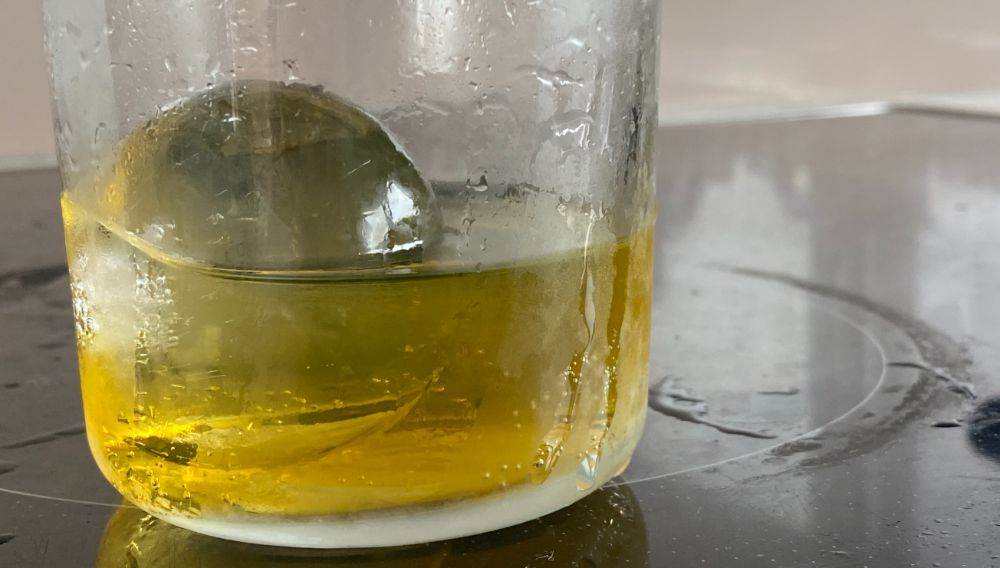
When water is frozen, the molecules slow down and bind together to make a solid. The molecules in a liquid move quickly and generate more heat as a result.
When you add an ice cube to a drink, the bonded molecules are exposed to the kinetic energy from the liquid. This addition of energy “excites” the molecules and gets them moving.
As the molecules move, they break apart and become a liquid. This process is how ice melts.
Yet, the ice isn't the only thing impacted by a change in kinetic energy. The molecules in the surrounding liquid slow down as the bonded molecules absorb the heat.
While the liquid doesn't bind and freeze, it is chilled by the process. Ice doesn't chill drinks by exposing them to the cold – it actually absorbs the heat from the liquid making that liquid colder as a result.
Stainless steel ice cubes follow the same process, but their heat capacity is significantly less. This means stainless steel ice cubes can absorb less heat from the surrounding liquid.
They also absorb this heat much faster as they are a good conductor so they stop helping your drink stay cold rather quickly.
How Long Would Pure Stainless Steel Keep Drinks Cold?
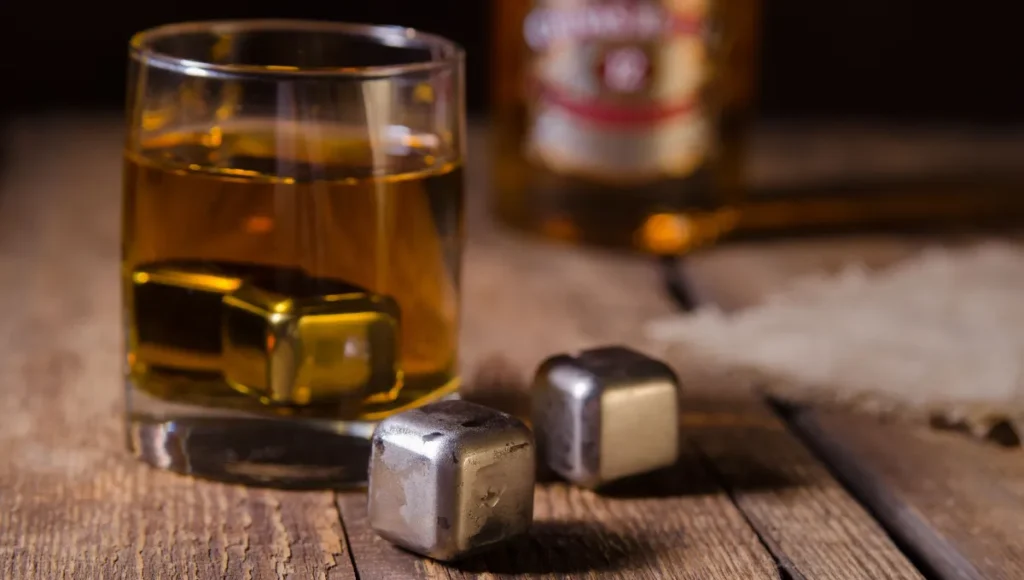
There's a common misconception that stainless steel ice cubes are pure stainless steel. They aren't!
This small change drastically affects how well they work. If they were pure stainless steel they wouldn't keep drinks cold for long at all, but because they contain liquid inside them they do work rather well.
While the outer shell may be pure stainless steel, these cubes typically contain a water or gel core.
The gel is similar to what you'd find in an icepack. This core helps the stainless steel stay colder for longer than it would if it was a solid steel block.
However, water will still be more effective at keeping your drinks cold.
Stainless steel ice cubes only tend to last half the time of water-based ice cubes as they only contain approximately 50% of the water that a regular ice cube would for the same size.
Does Stainless Steel Get Colder Than Ice?
There's another misconception that stainless steel gets colder than ice. Both stainless steel ice cubes and ice will get as cold as the freezer temperature and no colder.
The recommended freezer temperature is -18°C (0° F). Both stainless steel and water-based ice cubes will reach this temperature and remain at this point until removed from the freezer.
The difference lies in how quickly each material will reach that temperature. As stainless steel has a significantly lower heat capacity, these ice cubes will freeze much faster than water.
Benefits of Stainless Steel Ice Cubes
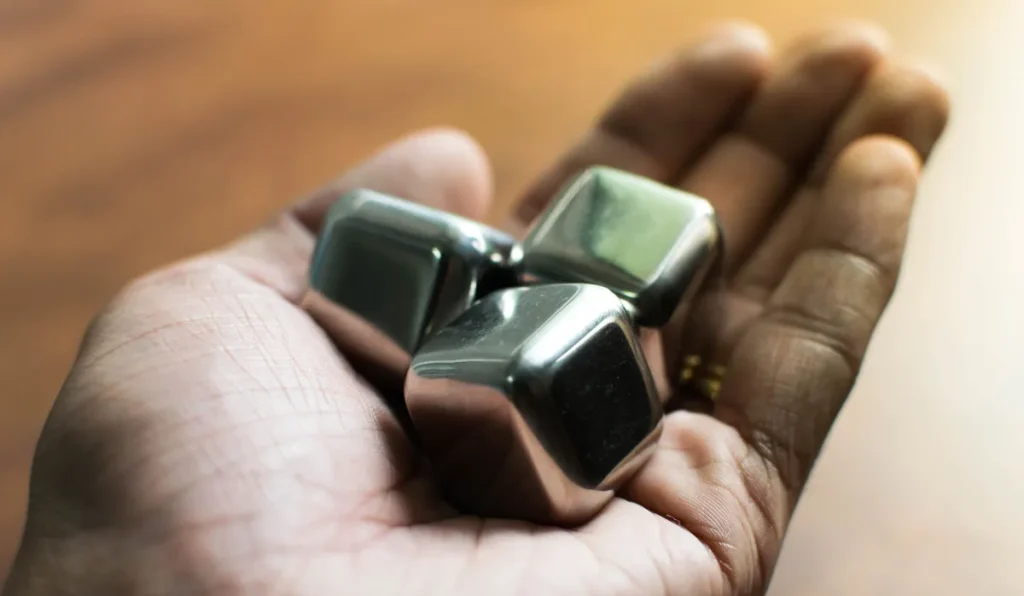
If water ice cubes keep drinks colder for longer, why bother with stainless steel ice cubes? While you wouldn't use stainless steel to keep a cooler cold, this option has several benefits that make it a worthy contender.
No Melt in Drinks
The main reason most people choose stainless steel ice cubes is to avoid watering down their drinks. You might not want to water down a nice scotch or whiskey or ruin the flavor or dilute it too much with the water from the ice.
Whiskey stones are a popular alternative to stainless steel cubes or rocks. These are usually made from soapstone or granite, which both have a specific heat capacity of 780-790 J/kg C°.
Still nowhere near as good as water in terms of heat capacity, but better than pure stainless steel. Plus they look great.
Large round ice cubes are great in whiskey as they are the slowest melting ice cubes do have the benefits of high heat capacity but melt slowly so don't dilute the drink as much. Click here to learn how to make clear ice cubes for whiskey.
Reusability
Stainless steel ice cubes can be an eco-friendly alternative to water-based ice cubes as they are completely reusable.
If you prefer cold drinks all day long, this sustainable alternative will help you cut back on your water consumption.
Stainless steel is also a better option than silicone or plastic-based reusable ice cubes due to the fact it won't leach chemicals into your drink like plastic might.
Freeze Faster
As the specific heat capacity of stainless steel is so much lower than water, these ice cubes get cold faster. That means you can throw the cubes back in the freezer and use them again before a tray of water freezes.
Having a few sets of stainless steel ice cubes to swap out will help you keep your drinks cold continuously without ever watering it down — just rinse and reuse.
Safe From Contaminants
Stainless steel poses less risk of releasing contaminants into your drinks. This is a valid concern for digital nomads and travelers in underdeveloped countries.
Travelers are often warned about the risks of consuming icy drinks on tropical vacations, as they can carry Hepatitis A. This viral liver infection can cause severe gastrointestinal distress and dehydration resulting in hospitalization.
While vacationers aren't likely to carry metal ice cubes with them to a tropical resort, these are a great addition to a camping cooler. You can use stainless steel ice cubes rather than the ice in your cooler that's come in contact with food and meat.
Stainless steel is also easy to clean and is naturally odor-repellent, making it less likely to take on tastes or odors from your freezer.
Are Stainless Steel Ice Cubes Worth It?
Stainless steel ice cubes are a great, eco-friendly way to keep drinks cold. However, ice is much better at keeping drinks colder for longer.

